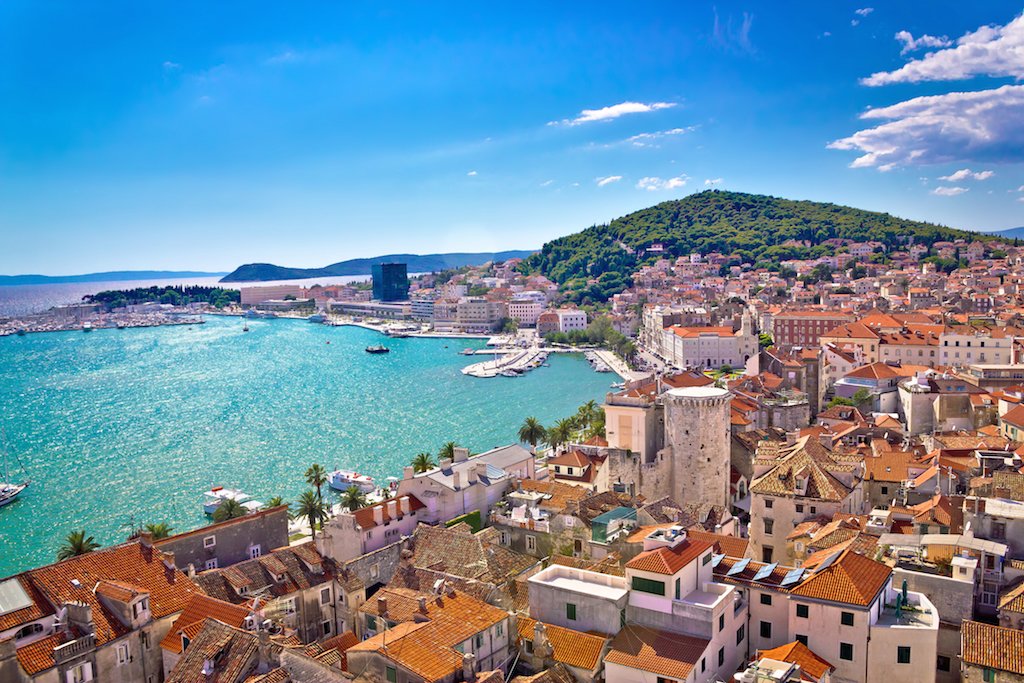
A dynamic port city with a medieval Old Town grown out of the 1,700-year-old Diocletian’s Palace, Split bustles with modern life amid its ancient Roman setting. Cafés, restaurants, and galleries cram the cobblestone alleyways, the waterfront and Marjan peninsula teem with outdoor activity, claiming Croatia’s second-largest city as one of the Mediterranean’s most compelling. Read on and discover the unique ways in which to spend your time in exuberant Split.
## Unveiling the Enchanting City of Split: A Comprehensive Exploration
Split, a city that effortlessly blends the echoes of ancient empires with the vibrant pulse of modern life, offers an unparalleled experience for every traveler. Here, the whispers of Roman emperors mingle with the aromas of freshly caught seafood, creating a symphony of sensations that captivate the senses. From the awe-inspiring ruins of Diocletian’s Palace to the exhilarating thrill of active excursions, and from the sophisticated ambiance of world-class restaurants to the electric energy of its nightlife, Split is a destination that truly has something to offer everyone.
At the heart of Split lies the magnificent Diocletian’s Palace, a UNESCO World Heritage site dating back to the 4th century. This remarkable structure, built by the Roman Emperor Diocletian as his retirement residence, is the city’s undisputed centerpiece. The majority of Split’s most captivating attractions are clustered around the palace’s well-preserved remains and its ingenious transformations, all nestled behind the picturesque Riva waterfront in the heart of Old Town.
Beyond the labyrinthine network of pedestrian-only streets and charming neighborhoods that surround Diocletian’s Palace, lies the verdant embrace of the Marjan peninsula. This wooded haven offers a tranquil escape from the urban bustle, with a collection of inviting pebble and shingle beaches that gently caress the coastline, all conveniently accessible from the city center.
Venture further afield, and you’ll encounter Split’s unique take on suburbia: a captivating tapestry of palms and exotic flora interwoven with the architectural fabric of socialist-era housing blocks. And just beyond the city limits to the northwest, lies the Dalmatian hinterland, known locally as *Zagora*, a delightfully unpopulated region brimming with unspoiled natural beauty, waiting to be explored.
## Crafting Your Perfect Split Adventure: A Detailed Itinerary
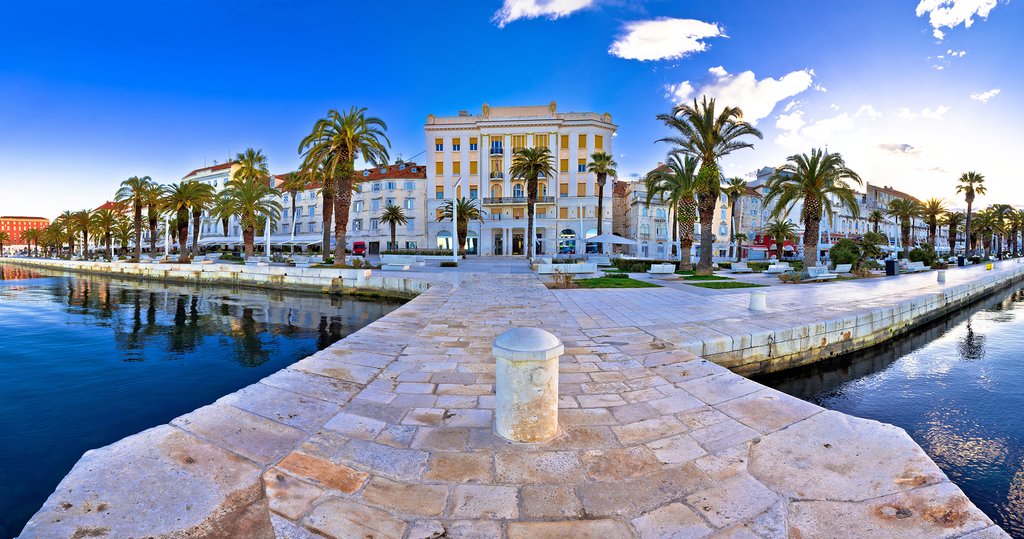
Strategically positioned along the sun-kissed Adriatic coast, Split serves as the central nexus from which the entire Dalmatian region unfolds. To truly appreciate the city’s main attractions, allocate at least a full day for exploration before venturing further into the wonders of Croatia.
Consider embarking on a meticulously crafted journey, such as a comprehensive “Best of Croatia” itinerary spanning 13 days. This carefully curated experience dedicates two enriching nights to Split, incorporating a captivating historical walking tour that unveils the city’s most noteworthy landmarks. These include, of course, the iconic Diocletian’s Palace, the vibrant Pjaca Square, and the historic 15th-century Town Hall, each a testament to Split’s rich and layered past.
Alternatively, transform Split into your strategic home base, from which to launch exciting day trips to nearby hotspots and lesser-known towns. A four-night stay in Split provides ample opportunity for three action-packed days, filled with unforgettable experiences such as sailing to the serene Šolta island, immersing yourself in the natural wonders of Krka National Park and the underrated charm of Šibenik, and exploring the historical tapestry of Trogir, the imposing Klis fortress, and the ancient Roman settlement of Salona. This adventure promises to unveil the hidden gems of Dalmatia.
### Selecting the Ideal Time to Immerse Yourself in Split’s Charm
Split is a city that transcends seasonal limitations, offering a unique and compelling experience for travelers throughout the year. Even during the cooler winter months, escaping the harshness of northern climates to the Dalmatian coast can be a rewarding experience. While a certain chill may linger in the air, Split’s historic center transforms into a tranquil haven, free from the throngs of tourists. The city’s vibrant arts scene comes alive, and nearby destinations such as Krka National Park undergo a breathtaking seasonal metamorphosis, well worth witnessing. Moreover, significant savings on airfare and accommodations can be found during this off-peak period.
However, the undisputed prime time to visit this Croatian jewel is during the shoulder seasons of April, May, and the beginning of June. During this period, the weather gradually warms, painting the city in pleasant sunshine, while the tourist crowds remain manageable, ensuring a more intimate experience. Hotel rates and transportation costs are also typically lower during this time, making it an economically sound choice. While the Adriatic Sea might still be too brisk for leisurely swimming, especially in April and May, consider visiting Split towards the end of September or in October. This period offers all the advantages of the shoulder season, with the added benefit of the sea becoming an inviting venue for watersports enthusiasts.
For deeper insights into the optimal time to plan your trip, consult resources dedicated to the best time to visit Croatia, providing valuable information to tailor your experience to your preferences.
### Navigating Your Journey to Split: A Transportation Guide
Split’s strategic location in the heart of Europe makes it easily accessible by air from most major cities, positioning it as the perfect starting or ending point for any adventure within Croatia or elsewhere in Europe. Reaching downtown Split from the airport is a straightforward and relatively inexpensive process, typically taking between 30 and 40 minutes. The options range from the most costly to the least: hailing a taxi, boarding the airport shuttle, or utilizing the local bus service. It’s important to note, however, that the bus from the airport drops passengers off approximately a 25-minute walk north of the city center, a significant portion of which is pedestrian-only.
Once in Split, the most convenient way to explore the city is on foot. However, if your itinerary includes visits to the Marjan peninsula or outlying neighborhoods and museums, utilizing the city’s efficient bus network is recommended. The main bus station is situated on Obala kneza Domagoja, directly opposite the ferry terminal. From here, buses depart frequently to a multitude of towns, both near and far, including Dubrovnik (hourly departures; approximately 4 hours and 40 minutes) and Zagreb (12 daily departures; travel time ranging from 5 to 9 hours). International routes are also available, connecting Split to destinations such as Belgrade, Ljubljana, Mostar, and Sarajevo.
A short five-minute walk north of the bus station, towards Old Town, lies the train station, offering passengers the option of traveling to Zagreb. Three trains depart daily, including one overnight service, with journey times ranging from 6 to 9 hours.
As the Adriatic’s primary ferry port, Split provides travelers with a plethora of destination options via ferry, catamaran, and hydrofoil. You can book passage to a variety of stunning destinations, including Dubrovnik, Lastovo, Korčula, Hvar, Brač, and Šolta. The main terminal is located at the end of Obala kneza Domagoja, at Gat sveti Duje. Tickets and reservations can be purchased from numerous kiosks along Obala kneza Domagoja, as well as inside the main passenger terminal. Alternatively, consider hiring a speedboat or joining a sailing tour to explore some of the Adriatic’s most popular islands directly, offering a more personalized and flexible experience.
If you choose to rent a car, it’s generally advisable to do so after your stay in Split. When planning your travels, be sure to factor in extra time, as delays are common during the summer months due to heavy coastal traffic.
## Unforgettable Experiences: Highlights and Activities in Split
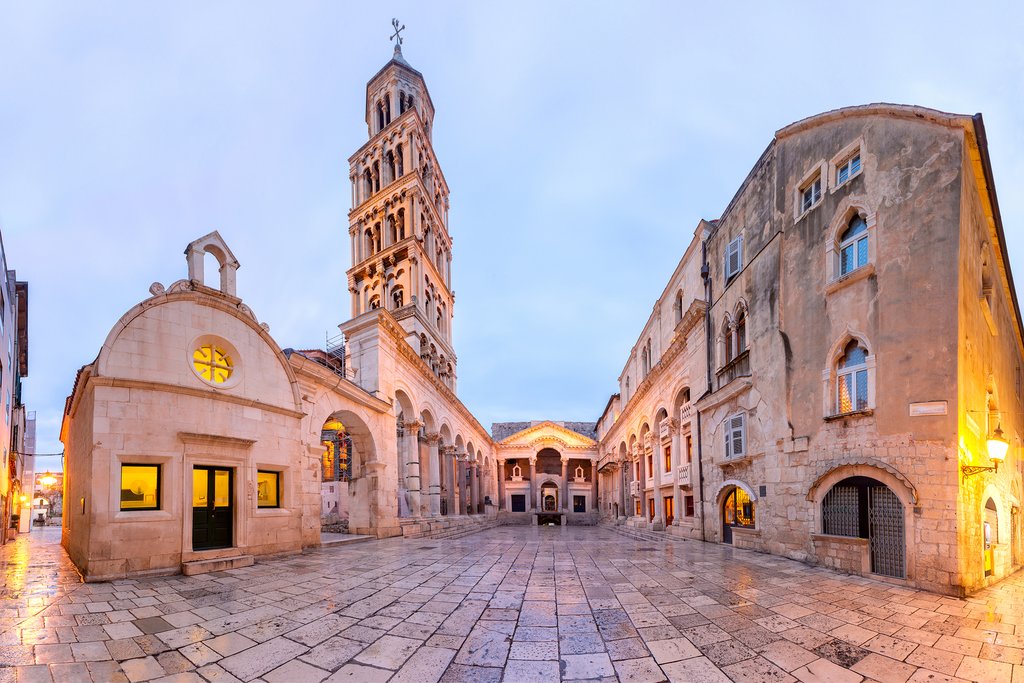
### Immerse Yourself in the Majesty of Diocletian’s Palace
An unavoidable and utterly captivating landmark, the UNESCO-protected **Diocletian’s Palace** in Old Town has evolved over centuries to become the vibrant heart of Split. This palatial retirement home, commissioned by Roman Emperor Diocletian in the early 4th century, bears little resemblance to its original Roman form due to centuries of adaptations and transformations. Medieval tenements have replaced the imperial apartments, utilizing salvaged stone in their construction. Today, shops, cafes, and a collection of charming flats line the palace walls that stretch along the Riva. However, the mausoleum and **Temple of Jupiter**, now serving as the cathedral and baptistry, respectively, still stand as powerful reminders of the palace’s ancient origins.
Begin your exploration in the **Peristyle**, the former central courtyard of the palace complex, now a bustling square and popular meeting place. To fully appreciate its beauty and tranquility, it’s best to arrive early, before the crowds descend. Greet the enigmatic black stone sphinx, brought back from Egypt 3,500 years ago, a silent witness to the palace’s long and eventful history. Then, ascend the six stories of the Romanesque campanile of the **Cathedral of St. Dominus**, a rewarding climb that provides a breathtaking panoramic view of the city’s layout and orientation. Follow the narrow alleyway to the baptistry to admire the well-preserved figures of Hercules and Apollo, alongside later additions of Christian iconography, reflecting the palace’s transition through different eras.
Venture into the basement, accessible next to the **Bronze Gate**, to gain a sense of how the palace might have appeared in its original splendor. The basement layout mirrors that of the original palace complex, offering a glimpse into the past. Today, you can browse and purchase souvenirs and gifts from the handicraft stalls that line the halls, adding a modern touch to this ancient space.
**Expert Tip**: Take an evening stroll along the **Riva** and then wander into the palace for a serene and romantic take on the otherwise bustling complex. The soft lighting and quiet atmosphere create a magical ambiance, allowing you to connect with the palace’s history on a deeper level.
### Wander Through the Charming Medieval Streets
Explore the gleaming tiles of *Narodni trg*, the “People’s Square” (more commonly known as **Pjaca**), located just outside the **Iron Gate**. Here, you can explore the temporary art or history exhibits hosted on the ground floor of the 15th-century *Gradska Vijećnica* (the **Town Hall**), and admire the Romanesque **clock tower**. Navigate the narrow medieval streets and passages west of the square or south toward the small square of **Mihovilova širina** to discover a wide array of cafe-bars, perfect for spending a warm evening, soaking in the atmosphere.
Further west lies the pedestrianized thoroughfare of **Marmontova**, a boundary to medieval Split, leading to **Trg republike** at its southern end. Here, you can admire the three-sided neo-Renaissance city council buildings, known as **Prokurative**, painted in vibrant colors, which also serve as a summer venue for outdoor concerts.
### Experience Split Like a Local: The Joys of Local Shopping
Planning a picnic or simply seeking to immerse yourself in the local culture? Head to one of Split’s bustling markets. East of Diocletian’s Palace, just outside the Silver Gate, lies the **Pazar Market** (Green Market), a lively fruit and vegetable market where farmers from the surrounding areas of Split gather to buy and sell a wide array of goods, from local produce and brandies to olive oils, cured meats, cheeses, kitchen supplies, and even clothing.
**Expert Tip**: Visit Pazar after 12 pm to bargain for lower prices, as vendors are often more willing to negotiate as the day progresses.
Follow your nose to the pungent **Peskarija fish market**, located halfway up Marmontova Street. Here, fishmongers enthusiastically announce their daily catch, and locals come to purchase the freshest seafood. The market is open from 6:30 am until 2 pm daily. Conveniently, you won’t have to worry about flies spoiling your experience or the seafood, thanks to the unique aroma emanating from the underground sulfur springs.
Emulate the fashion-forward women of Split and browse the **boutiques** for trendy clothing, footwear, and accessories, nestled within the charming streets of Diocletian’s Palace.
### Delve Deep into Split’s Rich History: A Journey Through Time
Split is home to a wealth of galleries and museums, each offering a unique perspective on the city’s rich history and cultural heritage. Within the walls of Diocletian’s Palace, you’ll find three exceptional museums that illuminate Split’s story throughout the centuries. Discover folk costumes displayed in renovated medieval rooms of the Božičević Palace at the **Ethnographic Museum**, admire the works of local artist Emmanuel Vidović and his curios in his recreated studio inside the **Vidović Gallery**, or explore the 15th-century Gothic Papalić Palace, showcasing archaeological finds from Diocletian’s Palace, housed within the **City Museum**.
For a glimpse into Illyrian, Greek, and primarily Roman artifacts, venture to the **Archaeological Museum**, Croatia’s oldest museum, where many of the findings originate from nearby Salona, the former capital of Dalmatia. Exhibits include votive figurines and amulets, as well as Greek, Roman, and early Christian stelae and sarcophagi. Meanwhile, the **Museum of Croatian Archeological Monuments** focuses on Split’s medieval heritage, often overshadowed by Diocletian’s Palace, and the **Croatian Maritime Museum**, housed within a 17th-century bastion, showcases nautical-related artifacts.
### Immerse Yourself in Art: A Feast for the Senses
Art enthusiasts will want to explore the artworks created by local and national artists, with a focus on Dalmatia, at the **Split Art Gallery**. Housed in the expansive halls of a renovated hospital to the northwest of Diocletian’s Palace, the gallery offers a beautiful space to experience the history of local Croatian art, from the 14th century to the present day.
A 20-minute walk from the city center will bring you to the **Ivan Meštrović Gallery** in Marjan Forest Park. This palatial estate-turned-gallery showcases 192 sculptures, hundreds of drawings, and a selection of paintings by Croatia’s most famous modern sculptor, Ivan Meštrović. Even if you’re not an art aficionado, the gallery is worth visiting for the breathtaking scenic views alone. Just a five-minute walk up the road from the gallery is the **Kaštelet**, a former 16th-century fortified residence that Meštrović acquired to display his powerful **Life of Christ** series.
**Expert Tip**: Obtain free admission or up to 50% off admission to select museums and galleries with the **SplitCard**. The card is free depending on the duration of your stay (5 nights in summer, 2 in winter), making it a worthwhile investment for culture enthusiasts.
### Embrace Nature: Hiking, Trails, and Beaches of the Marjan Peninsula
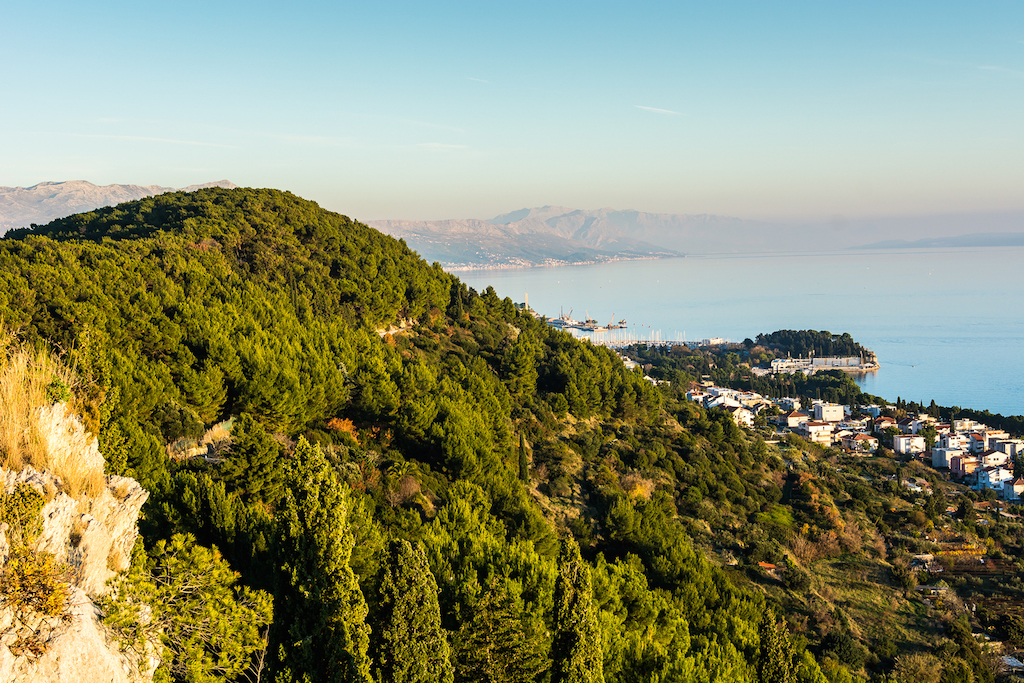
Just beyond the city center lies the undeveloped green oasis of the **Marjan peninsula**, roughly the same size as New York City’s Central Park. Enveloped by pine and cypress trees and the azure sea, this is the perfect escape from the urban hustle, offering endless trails for running, walking, and cycling, as well as access to inviting beaches for kayaking, swimming, sunbathing, and rock climbing.
Pack a picnic lunch and hike to the summit of the 560-foot (170-m) **Marjan Hill**, to **Telegrin Peak**, for breathtaking panoramic vistas of the city and the nearby islands. Even better, arrive in the late afternoon to witness the spectacular sunset as it paints the sky with vibrant colors, sinking into the Adriatic Sea. The peninsula also boasts a few lesser-visited attractions, including the **Jewish cemetery** (with tombstones dating back to the 1700s) and the charming 13th and 15th-century churches, **St. Nicholas** and **St. Jerome**.
Hire a **bike** near the northern entrance of the park or join a half-day cycling tour to pedal the shaded paths that weave through the woods and take a refreshing dip at the secluded **Kašjuni beach**. This strip of fine shingle, with limited access to facilities, faces the verdant island of Čiovo, further enhancing the feeling of being far removed from the bustle of Split.
**Expert Tip**: Take bus #12 to **Bene bay** to discover a mix of concreted and rocky bathing areas and inviting cafes, allowing you to hop on and off the bus throughout the park. The bus departs every hour from the end of the Riva, in front of the **Church of St. Frane**.
### Fun in the Sun: Splash at Bačvice Beach and Play a Round of Picigen
Elsewhere in Split, you’ll find a couple of popular beaches, notably the centrally located **Bačvice beach**. Popular with locals and families, thanks to its ideal location, sandy and shallow bottom, children’s playground, and nearby cafes and restaurants. This is also where the unique sport of **picigen** was born, a game played exclusively in and around Split. A netless version of volleyball played in the sea, picigen involves participants leaping and splashing as they attempt to prevent a peeled tennis ball from touching the water. If you’re feeling adventurous, make friends and join in a round or two.
### Dive into Adventure: Explore the Underwater World
Walking around Split, you’ll notice numerous dive shops, and for good reason: the coastline is dotted with islands and reefs, and the waters are exceptionally clear due to their calm nature. If you have more than a few days in Split, embark on a half-day scuba diving venture to admire colorful schools of curious fish, delicate corals, and exotic-looking sponges and snails.
### Experience Local Passion: Attend a Football Match
Catch a **Hajduk Split** football (soccer) match from February to May in Split’s **Poljud Stadium**, within walking distance of Old Town. Besides the magnificent views of the sea and mountains, you’ll rub shoulders with passionate locals as they fanatically cheer on their team. If you manage to secure tickets to a match against arch-rivals Dinamo Zagreb, you’re in for a particularly memorable experience.
**Expert Tip**: You can often buy decent tickets on the day of a match for around $10, making it an accessible and authentic local experience.
### Indulge in Dalmatian Flavors: Savor Wine in Split
To get a taste of Dalmatian wine, visit the **Klub Gurmana I Hedonista** wine bar, a 10-minute walk from the city center. This charming wine bar is located inside a traditional stone building, where the host speaks fluent English and serves delectable finger foods perfectly paired with the right wine. Alternatively, consider a 25-minute drive outside of Split to the town of **Kastela**, where Zinfandel is popular, and visit the **Putalj Winery**. You can visit independently if you have a car or join a guided wine tour for a more structured experience.
**Expert Tip**: Reservations are essential if you join a tasting/tour, and it’s advisable to book well in advance, as they typically occur once daily (at 5 pm).
### Witness Nature’s Canvas: Take in the Setting Sun
If you find yourself in **Old Town** during sunset, grab a blanket and a bottle of wine and stroll to the western end of the Riva, where the dock extends out into the harbor. This quieter area, away from the bustle of Old Town, provides a romantic spot to watch the sky transform from day to night.
For an elevated view, visit the laidback **Konoba Dioklecijan**, a local favorite that serves small nibbles (be sure to try a snack or sandwich of pršut) alongside refreshing cocktails. Its outdoor terrace is built directly into the wall of Diocletian’s Palace, near the **Bronze Gate**. Grab a drink, sit out on the terrace overlooking the waterfront, and take in the sun as it dips below the horizon.
During the summer months, younger locals gather to socialize and drink around a popular spot called **Matejuška**, the old fisherman’s cove near the Riva. Pick up some beer from **Mali dućan** (Little Shop), which boasts the largest selection of beers in town, and mingle with the locals, immersing yourself in the authentic Split lifestyle.
### Embrace the Local Rhythm: Roam the Riva and Practice the Art of Fjaka
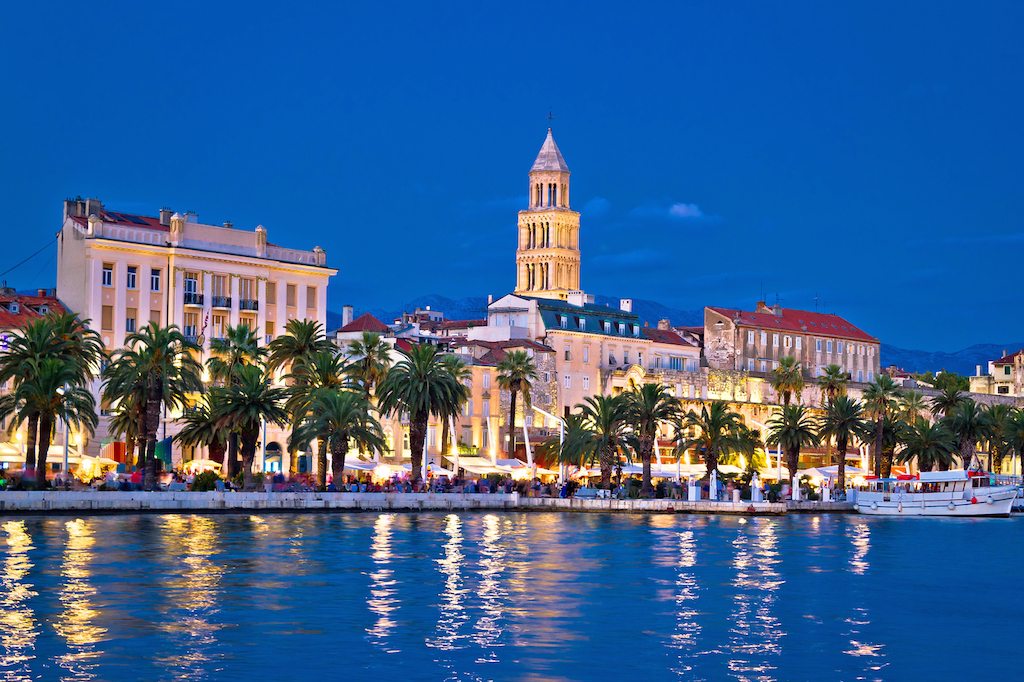
After a full day of sightseeing, embrace the local way of life and practice *fjaka*, the simple art of doing nothing. This is not to be confused with mere laziness; fjaka is the sublime state of mind and body in which you *aspire for nothing*. Though it cannot be learned, head to Split’s waterfront promenade and stroll the **Riva** without a specific purpose, allowing your body to relax as you empty your mind. If that proves challenging, choose a cafe to people-watch from and see if you can spot locals in a languid state, an inherent part of fjaka.
## Beyond Split: Exciting Day Trip Destinations
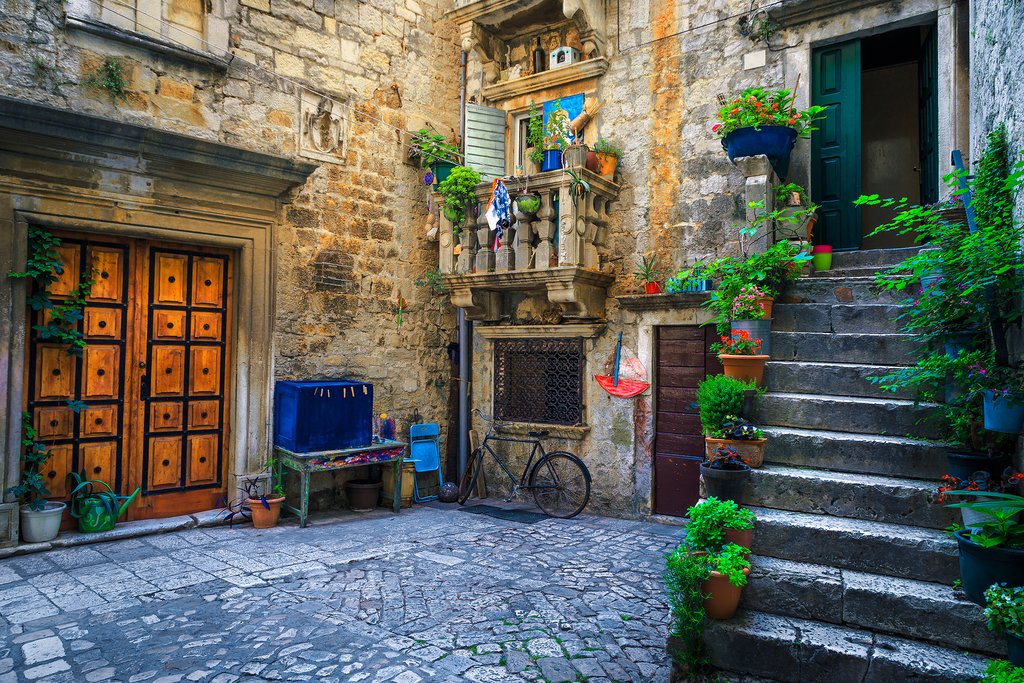
### Thrill Seekers: Hike, Climb, Swim, & Zip Down the Cetina River
Embark on an early start to the day and drive south along the coast to **Zadvarje** for a full-day excursion, where you’ll be outfitted for a day of rafting and canyoning down the **Cetina River**, with the optional addition of ziplining in **Omiš**.
### Island Escapade: Sail the Sparkling Sea to Nearby Adriatic Islands
Enjoy the invigorating sea breeze and sunshine as you relax and indulge your senses onboard a private sailboat, stopping along the way to swim, snorkel, and explore the charming coastal towns of **Vis**, **Korčula**, **Hvar**, and **Brač**.
### Culinary Delights: Join a Cooking Class in Trogir
A mere 45-minute drive west of Split lies the island-city of Trogir, a UNESCO World Heritage Site brimming with fascinating architecture. Learn the secrets of Dalmatian cuisine in this centrally located gem, discovering how to cook a traditional Croatian *gozba* (feast).
### Adventurous Exploration: Zoom Through the Zagora
Explore the Zagora, the hinterland beyond Split, on a family-friendly ATV tour, traversing gravel roads and sparsely populated fields along the Cetina River, as well as enjoying a refreshing dip in the river and a delightful barbeque lunch.
B-639
